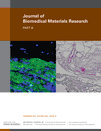Evaluation of bone regeneration, angiogenesis, and hydroxyapatite conversion in critical-sized rat calvarial defects implanted with bioactive glass scaffolds†
How to cite this article: Bi L, Jung S, Day D, Neidig K, Dusevich V, Eick D, Bonewald L. 2012. Evaluation of bone regeneration, angiogenesis, and hydroxyapatite conversion in critical-sized rat calvarial defects implanted with bioactive glass scaffolds. J Biomed Mater Res Part A 2012:100A:3267–3275.
Abstract
Bioactive glasses are biocompatible materials that convert to hydroxyapatite in vivo, and potentially support bone formation, but have mainly been available in particulate and not scaffold form. In this study, borosilicate and borate bioactive glass scaffolds were evaluated in critical-sized rat calvarial defects. Twelve-week-old rats were implanted with 45S5 silicate glass particles and scaffolds of 1393 silicate, 1393B1 borosilicate, and 1393B3 borate glass. After 12 weeks, the defects were harvested, stained with hematoxylin and eosin to evaluate bone regeneration, Periodic Acid Schiff to quantitate blood vessel area, and von Kossa and backscatter SEM to estimate newly mineralized bone and hydroxyapatite conversion of bioactive glasses. The amount of new bone was 12.4% for 45S5, 8.5% for 1393, 9.7% for 1393B1, and 14.9% for 1393B3 (*p = 0.04; cf. 1393 and 1393B1). Blood vessel area was significantly higher (p = 0.009) with 45S5 (3.8%), with no differences among 1393 (2.0%), 1393B1 (2.4%), or 1393B3 (2.2%). Percent von Kossa-positive area was 18.7% for 45S5, 25.4% for 1393, 29.5% for 1393B1, and 30.1% for 1393B3, significantly higher (p = 0.014) in 1393B1 and 1393B3 glasses than in 45S5. 45S5 and 1393B3 converted completely to HA in vivo. The 1393B3 glass provided greater bone formation and may be more promising for bone defect repair due to its capacity to be molded into scaffolds. © 2012 Wiley Periodicals, Inc. J Biomed Mater Res Part A 100A:3267–3275, 2012.




